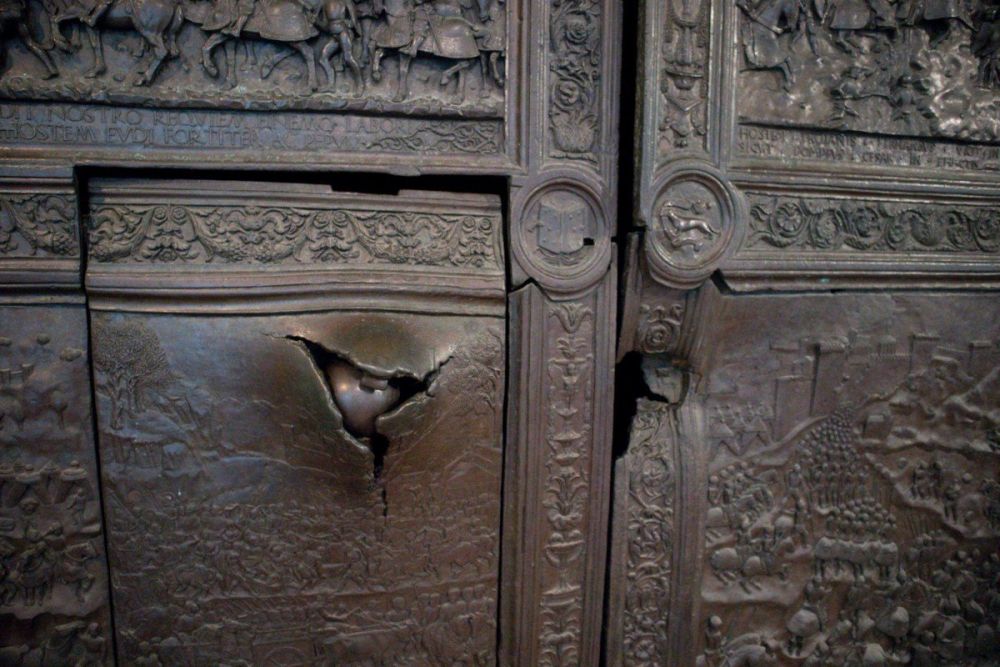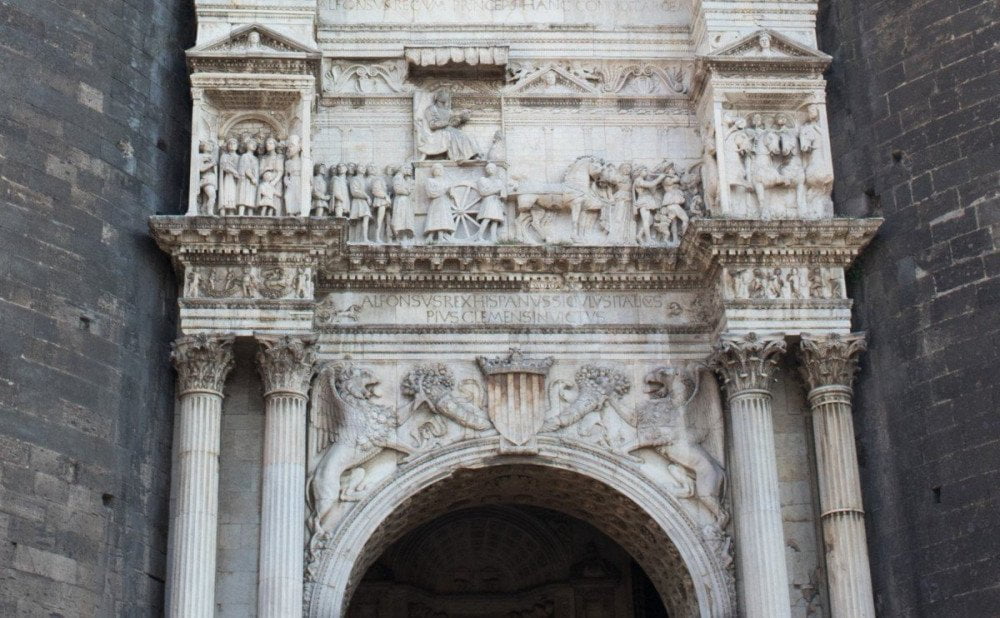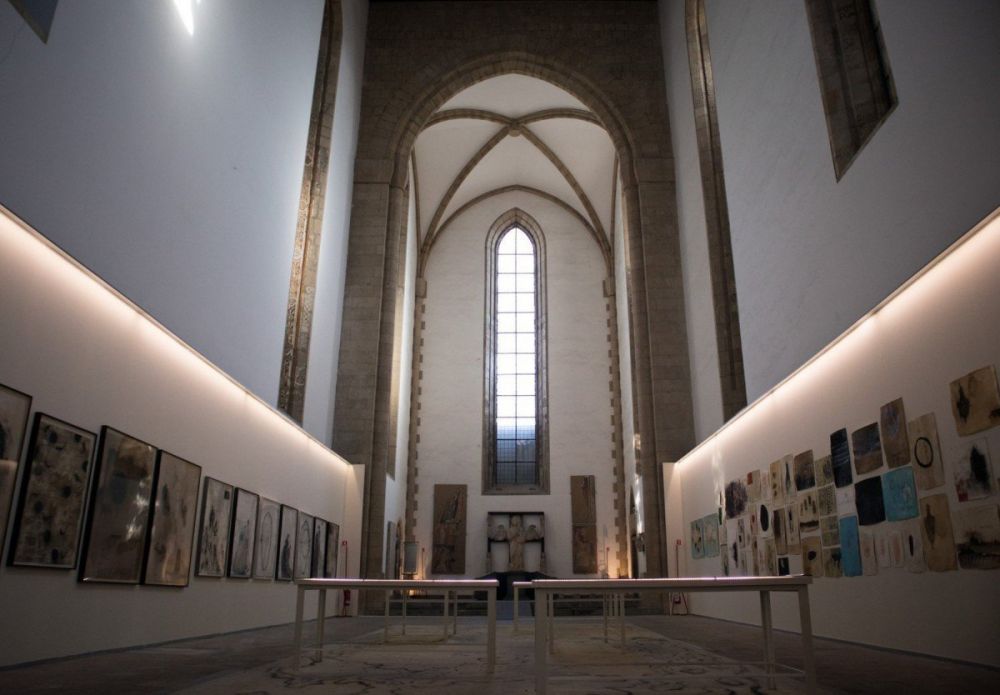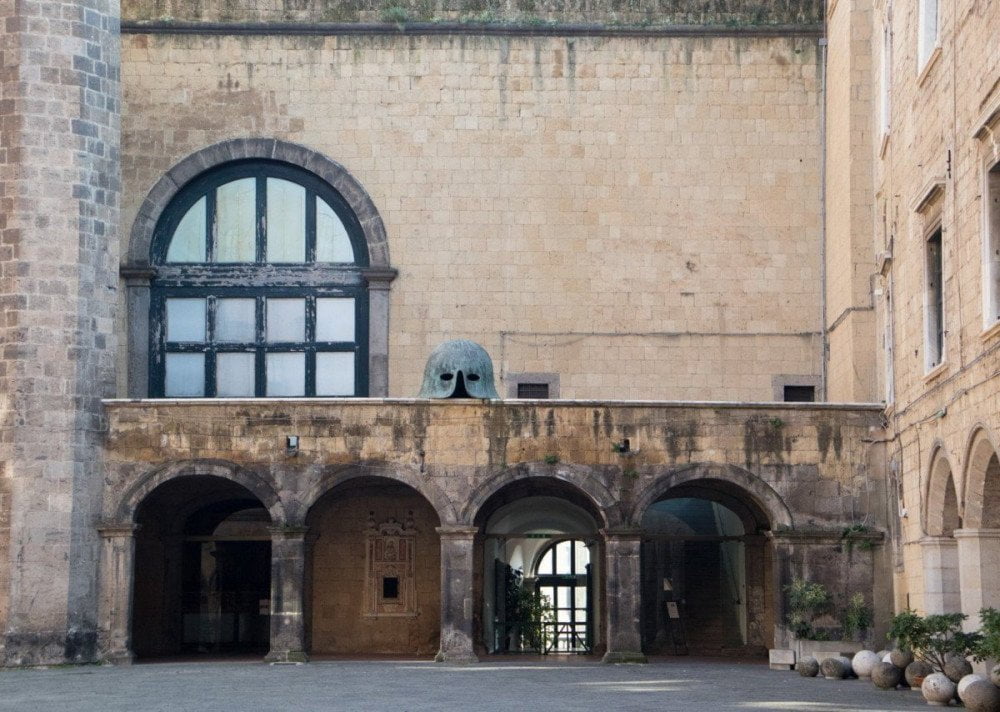Castel Nuovo, also known as Maschio Angioino, is a prominent symbol of Naples. Behind its walls and its massive structure, the castle holds intriguing legends and curiosities. As you can discover in this post, many historical and bloody events took place in the New Castle of Naples.
Table of Contents
Castel Nuovo of Naples: what’s on
Castel Nuovo houses two important attractions, the Biblioteca di Storia Patria (National History Library) and the Museo Civico (Civic Museum). The museum boasts an impressive collection of paintings by 17th-century Neapolitan artists and is worth a visit. One of its most notable exhibits is the original Castel Nuovo’s bronze door with a cannonball embedded in it. The door outside the castle, in fact, is merely a replica of this unique piece.
ORGANISE YOUR TRIP TO NAPLES
Get the Naples Pass to save money. The card gives you access to attractions like the underground city tour and the Catacombs of San Gennaro, and unlimited public transport during its validity.
To stay connected in Italy, remember to buy an Airalo eSim online, with data and phone coverage for your trip to Naples.
In 1495, the French king Charles VIII took the door of the castle with him as a souvenir. However, he encountered the Genoese during his voyage back home and lost the door during the naval battle. The door eventually returned to Naples, probably because the Genoese were unsure what to do with it.

Towers and walls of the Maschio Angioino
The current appearance of Castel Nuovo is different from the original d’Anjou design. In fact, the castle had a strong renovation ordered by Alfonso of Aragon. The Palatine Chapel is the only remaining part of the original castle. The current Maschio Angioino’s irregular trapezoid plan consists of five crenellated towers surrounded by a moat.
Each tower has a specific name: Torre di San Giorgio, Torre di Mezzo (Middle Tower), Torre di Guardia (Watchtower) towards the piazza, and Torre dell’Oro and Torre del Beverello towards the sea. Inside each tower is a spiral staircase called the ‘Catalan staircase’, which leads to the guard posts on the roof.
The Triumphal Arch of Castel Nuovo
Between the Watchtower and the Middle Tower stands the Triumphal Arch, built by Alfonso of Aragon to celebrate his conquest of the Kingdom of Naples in 1443. Behind the arch, you can see a replica of the bronze door with the cannonball, now exhibited in the museum.
The Neapolitan Arc de Triomphe has numerous sculptures of King Alfonso in various activities. At the arch’s highest point, Alfonso of Aragon strides into the city victoriously. At the same time, in the other bas-relieves, he stands among the captains and officers of the kingdom. The style is that of the classical triumphal arches of the Roman era. The upper part of the arch is dedicated to the virtues of Temperance, Justice, Fortitude, and Magnanimity. Other sculptures include also St Michael.

The Hall of Barons
The Hall of the Barons during the d’Anjou era must have been truly impressive. The walls, towering at twenty-eight meters high, were adorned with frescoes by Giotto, depicting the heroes of antiquity. The room remains astounding even without decoration due to its incredible height.
The ceiling is adorned with piperno, a grey Neapolitan stone. It contrasts with the yellow tuff stone used throughout the castle and hall. In the center of the vault is an oculus or hole, which allows light to filter through, adding to the grandeur of the room.
The slaughter of the barons
The Hall of the Barons was used by Robert of Anjou as a Throne Room. However, it is mostly known for a historical event that could have been part of George R.R. Martin’s books. This fact is quite similar to the Red Wedding episode of the Iron Throne.
In 1489, a group of nobles attempted to overthrow Ferdinand ‘Ferrante’ I of Aragon, the son of Alfonso of Aragon. This event is known as the Conjuring of the Barons. The plot ended in a political marriage between a niece of the king and the son of the Count of Sarno.
However, in reality, the wedding was just a pretext to lure the barons to the castle. There they were treacherously arrested and sentenced to death. The various sources differ in the degree of ferocity of the massacre, with some accounts stating that the few survivors were thrown into the castle dungeons for the rest of their lives.
The Palatine Chapel
One of the main attractions of Maschio Angioino is the Palatine Chapel, which Giotto frescoed with a cycle of stories from the Old and New Testaments. Unfortunately, only a few decorations have survived due to fires and earthquakes.
However, the Palatine Chapel is striking because of its structure, with a very high ceiling combined with a single nave. Walking inside the church makes you feel tiny, like a speck of dust in a vast corridor. Surprisingly, the Palatine Chapel can make us feel the presence of the divine, even without the decorations and splendour of the past.

Historical and cultural curiosities about Castel Nuovo
Castel Nuovo ‘New Castle’, or Maschio Angioino as the Neapolitans call it, was built in 1279 at the behest of King Charles I of Anjou, who wanted a new royal residence to use also as a fortress. However, King Charles I of Anjou was never able to live in Castel Nuovo because he died before the completion of construction.
The name derives from ‘Castrum Novum’ because it was the last castle added to the list of Neapolitan castles. The old Castel dell’Ovo was, in fact, no longer fit to defend the city. Castel Capuano was not in a strategic position, while Castel Sant’Elmo was not considered.
Castel Nuovo was the site of some important historical events thanks to the link between the Angevins and the Catholic Church. In 1294, Pope Celestine V, also known as Pietro da Morrone, renounced his pontificate in Castel Nuovo and returned to live as a hermit.
Giotto, Petrarch and Boccaccio in Naples
During the Middle Ages, Naples was an important centre of culture. Especially during the reign of Robert of Anjou, Castel Nuovo hosted the most famous artists and scholars of the time, including Boccaccio, Petrarch and Giotto. Unfortunately, Robert of Anjou suffered competition from the more famous Frederick II of Swabia, who raised the cultural level of neighbouring Sicily, leaving the Kingdom of Naples in the background.

The lustful Queen Joan and her crocodile
In the past, people gossiped about Queen Joan II and labeled her as a lustful and cruel woman. However, she was actually a very modern woman for her time. She preferred cohabitation over marriage, which she only entered into for convenience. During her reign, her ‘favourites’, lovers who were given a role in running the affairs of the state, held significant influence. Her manner, however, made her appear unhinged to her contemporaries.
According to popular legend, Queen Joan II chose her lovers from among good-looking commoners and threw them through a trapdoor in the castle the next morning to be eaten by a crocodile. While several versions of the Neapolitan legend exist, they all agree that the lovers were locked in a cell in the Maschio Angioino dungeon, which was connected to the sea by a trapdoor. A large crocodile, or sea monster, would then enter through the trapdoor to collect the take-away meal.
Why is Castel Nuovo called Maschio Angioino
Another name for Castel Nuovo is Maschio Angioino. The Italian word ‘mastio’, sometimes called ‘maschio’ (man), indicated the highest tower of medieval castles, the last possible defence in case of attack.
The term ‘mastio’ later came to mean castle or fortification. The ‘maschio’ (man) variant of ‘mastio’ seems to derive from the ‘mightiness’ of the towers instead. Indeed, the castle was friendly renamed Maschio Angioino.
Where to stay in Naples
Naples boasts numerous accommodations, from hotels to seaside flats. With my frequent visits to Naples, I can suggest several options. For an authentic experience in the historic center, consider The Idyll Boutique Apartment in the Spanish Quarter. This charming flat features parquet floors and a fully equipped kitchen, conveniently close to major attractions. Alternatively, the upscale Relais Della Porta, situated on Via Toledo, places you a short distance from landmarks like the San Carlo Theatre. Last but not least, the Santa Chiara Boutique Hotel, located near the Dante metro stop, offers a continental or Italian breakfast to start your day.
Share your experience if you’ve already visited Castel Nuovo or if it’s been a highlight of your Naples trip. Feel free to write in the comments any other intriguing legends associated with this iconic symbol of the Neapolitan city.
